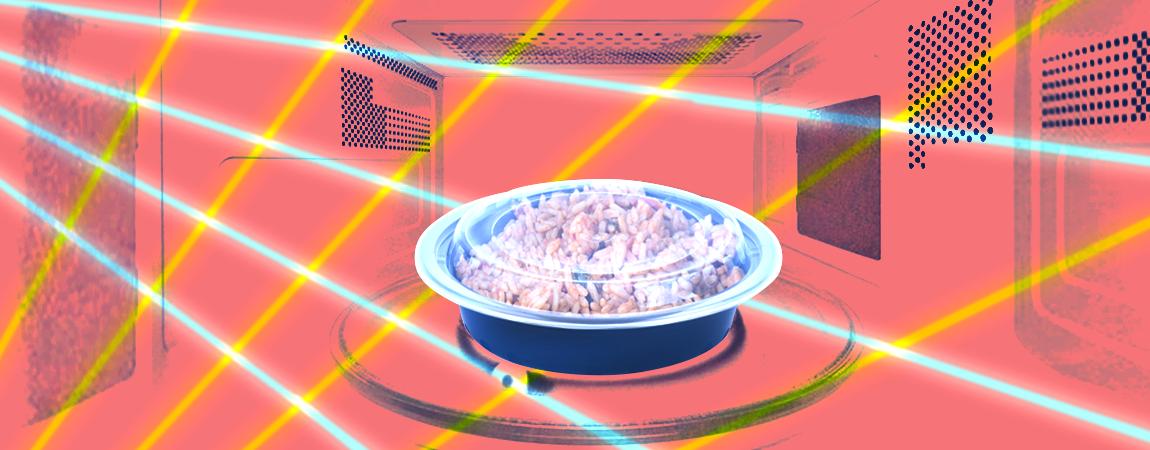
What Would Happen If You Microwaved A Non-Microwave-Safe Container?
This is What Would Happen If, a close examination of mundane hypothetical situations. Each week, we look at something that you could do but probably never would, and take it to its logical endpoint. This week: What would happen if you microwaved a non-microwave safe container?
The microwave is a vexing and mysterious cooking instrument. It causes marshmallows to explode, metal to spark and water to boil extremely fast. Plastics, despite their ubiquity, are also vexing and mysterious. They're clearly made with chemicals — chemicals that turned the humble Nalgene bottle into a health hazard.
The microwave is powerful, plastic can melt. It's not exactly crazy to feel a little apprehensive every time you go to reheat some food in a takeout container.
This is, partly, a labeling problem. Here in the US, the Food and Drug Administration is responsible for regulating what is microwave-safe. A plastic dish that meets their approval will say "microwave-safe" somewhere on the container, or feature a square icon with wavy lines.
The thing is, the FDA is not going out and testing every single plastic dish on the market, they're just set the testing standards for a microwave-safe dish. It's up to the manufacturer to test to the FDA's standards, and then label their goods as microwave-safe. In other words, there are microwave-safe containers, and then there are containers which have yet to be proven as microwave-safe.
So, what might happen if you accidentally microwave something in a container that isn't labeled as such? Is your food now infused with toxic chemicals? Rendered inedible by molten plastic? The answer, as always, is that it really depends.
The plastic industry has seven main types of plastics — all identified by those curious number-in-a-triangle symbols. When it comes to food containers — or what the FDA refers to as "food contact substances — there are four likely suspects: polyethylene terephthalate (PET, resin code 1), polypropylene (PP, resin code 5), polystyrene (PS, resin code 6) and polycarbonate (PC, resin code 7).
First, you should know that a 2011 study found that all plastics leech a detectable amount of chemicals that can cause something known as estrogenic activity, or EA. That is, chemicals that mimic estrogen, which if ingested can cause adverse health effects like early puberty in women, reduced sperm counts in men and increase the risk of ovarian, breast, testicular and prostate cancer. The key word here, however, is "detectable" and not "dangerous" — since it's yet to be determined what a "dangerous" level of EA-causing chemicals are.
But let's get down to practical concerns: More often than not, the container you're worried about is made from polypropylene. We're talking take-out containers, yogurt tubs, condiment bottles and those semi-disposable plastic containers. If you're reheating some food in a plastic container, there's a good chance it's made from PP.
Because these containers all contain food, the FDA has approved them as a "food-contact substance," meaning there's little to no risk of them leeching harmful chemicals into the food. The thing is, just because a PP container can be microwave-safe, doesn't mean that it is.
According to the American Chemistry Council, this is a bit of a gray area. "Choosing to microwave with a plastic item not labeled for microwave suitability isn't necessarily 'unsafe'," they advise in an online FAQ. "But you won't have the assurance of knowing the item was tested and evaluated for this purpose." The worst that might happen is that an especially thin PP container might start to soften or melt if left in the microwave long enough.
Another plastic you're likely to encounter is polystyrene, which you'll probably identify as foam takeout containers, cups and plates. These won't melt, but polystyrene containers are known to leech small amounts of styrene, a carcinogen, and microwaving those containers won't slow that leeching.
PP and PS containers make up just about everything you're likely to store food in, but there's a chance that you might run into bottles made from polyethylene terephthalate. We can't imagine you'd ever want to nuke a bottle of soda or juice, but when microwaved PET will leech antimony, a metal, which could lead to gastrointestinal problems.
The last plastic to worry about are polycarbonates. You might remember this plastic from the BPA scare in 2008. A chemical used in the creation of polycarbonate plastic, bisphenol A, was found to leech into foods and liquids, which can potentially impact the prostate gland of babies and cause high blood pressure. While the FDA assures that low-level BPA ingestion is safe, they banned polycarbonates containing BPA in 2012. So, if you own an older dish that sports a 7, microwaving food it in might expose you to BPA.
In any case, if you're really worried about if you should microwave those leftovers in a certain container, there's one really quick way to allay those fears: Just dump whatever is in that container onto a plate, and then heat it up.
If you're still a little apprehensive, trust the words of David Roylance, a plastics engineering professor at MIT. "Personally, I just microwave items willy-nilly and if they get hot that's good enough for me," he wrote to me in an email. "Others are more cautious, worrying the item might exude something dangerous – not likely, in my view."
Further Reading
The Sweethome's Guide To The Best Food Storage Containers
The New Yorker's Excellent Feature On The Public's Fear Of Plastic
The Music Video For Aqua's Smash 1997 Hit, "Barbie Girl"
Next Week
What would happen if you ate moldy food?
Got a burning (hopefully not in an infected way) hypothetical question? Submit it to [email protected]. And for more, check out our What Would Happen If archive.

